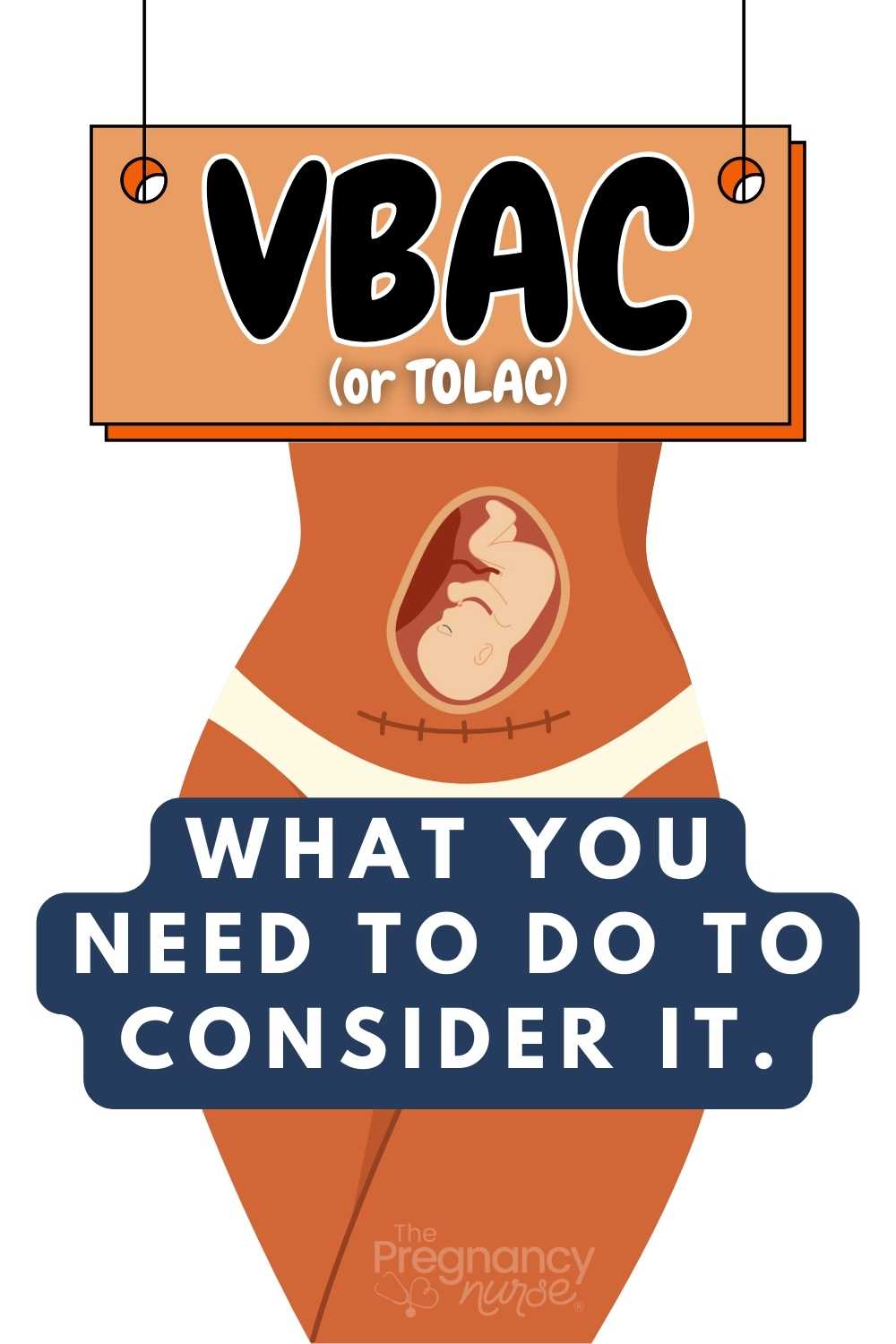You’re considering a VBAC and I LOVE that. That means a Vaginal Birth After Cesarean, but not all TOLAC (which is what you are as you’re attempting it) are created equal. Here are a few things you need to think about before planning for a VBAC.
Reminder of terminology.
- VBAC= Vaginal Birth After Cesarean (what you are if you have a vaginal birth)
- TOLAC = Trial Of Labor After Cesarean (what you are when you’re attempting it)
Before we get started, if you’re trying for a VBAC having a birth plan is SO important. Mostly because you’ll be able to think about what you really WANT and what lines you don’t really want to cross…. Grab my little birth plan helper here:
I must admit I’m a HUGE VBAC fan! I feel so triumphant when it happens. I, personally, believe every pregnant woman with a previous cesarean should consider it, but I know it’s not for everyone — so keep in close contact with your provider.

Ok, let’s jump into the three things I think ANY TOLAC patient needs to do:
Discuss With Your Provider
There are a LOT of things to talk about with your provider:
- How comfortable they are with TOLAC’s in general
- How comfortable they are with YOUR TOLAC (you may have reasons it shouldn’t be attempted)
- Bring them up to speed in detail as to why you had a C-section last time
- Ask them what barriers you might have to a VBAC this time
- If they would recommend you TOLAC.
Remember, it is your provider’s job to tell you the risks of what you’re considering. However, if your provider absolutely does NOT recommend VBAC’s in any case, it might be a good time to switch providers (if that is important to you).
However, most providers SHOULD be offering a TOLAC (in most, but not all instances). Here is ACOG’s stance on VBACS. In the US, ACOG rules what doctors are to do in situations, so reading through that page — that should align with what your provider tells you.
Your previous type of incision ON YOUR UTERUS is VERY important. While your incision on your skin may go horizontal, if you have a vertical incision on your uterus (most often used in other countries or in a true emergency in the US) is extremely high risk to labor with. It has the highest chance of uterine rupture.
Other cesarean questions — check out this article:
- What To Wear For A Cesarean Section
- How To Prepare For Your C-Section (Cesarean Section)
- C-Section Scar Pain During Early Pregnancy
- 16 C-Section Facts For A Better Birth!
- Cesarean Section Anesthesia
Chances of Happening Again
Ok, so you’ve talked with your provider about your previous birth. The big question is, what are the chances of it happening again? Let me give you some scenarios:
Last baby was breech, but this baby is head down…. that’s probably the BIGGEST case of being fine to try a VBAC. Check out my post on getting baby to flip if you have questions about that.
Last baby was mal-positioned — sometimes we can tell baby just came into the birth canal oddly (we call it wonky) where it’s head just didn’t flex right and they’re sort of coming into it with their head cocked. If this baby descends properly you’re very likely to have a VBAC. However, there’s still the chance that something in your uterus made them descend “wonky” and we won’t know until we try.
You had some illness and ended up needing a section — let’s say you had serious preeclampsia, but are free of it this time (that can happen). Or, you had a serious flu, or something really wrong. This time, with new conditions you’d be much more likely to try for a vaginal birth.
Baby didn’t tolerate labor (often called fetal intolerance to labor)– maybe baby had a cord wrapped around them, or some other issue, but just didn’t tolerate labor (their heart rate kept dropping). This baby might be different, you never know!
Baby never descended into the birth canal (often called failure to progress or failure to descend)– if baby is of a similar size there’s a chance this baby also won’t descend. You may have a narrow pelvis or some other issue with your uterus that doesn’t allow baby into the birth canal.
Of course, there’s LOTS of reasons why a cesarean happens — but these are some of the reasons they happen…. hopefully it gives you an idea of what we’re looking at.
You’re always going to have an “ear to the ground” seeing if what happened last time is going to happen again – -be it preeclampsia or baby not progressing right. It’s smart to do that! Doesn’t mean you have to act right away, but you sometimes do know the end of the story….
Understanding how labor normally progresses is REALLY important in this case. I recommend this to learn more about labor and what to expect this time (because it may be QUITE different):
Quick note: I think you need a FULL class vs just a VBAC class, so get prepared no matter what happens….
Remember the Golden Rule of VBAC:
There are two parts to the rule:
Your provider can not MAKE you have a C-section
You can not MAKE your provider induce you.
I think that remembering both of these reminds you what each of you can do in these situations.
I often hear providers say they “won’t let you have a VBAC” and that just isn’t true at all. Even with a vertical scar, you have the right to labor on your own (but you can’t make them induce you). I talked with a friend about this in here.
I just hope you consider the risks and benefits…..
Many induction agents can’t be given with previous cesarean histories (especially a vertical scar) or the providers could lose their license.
But ultimately it does boil down to this:
What’s the main risk of a VBAC?
Uterine rupture is the big one. This is where your uterus breaks open on your previous scar line and the contents spill into the abdominal cavity.
This could have serious consequences for both you and baby, including:
- Baby dying (obviously, them floating in your abdominal cavity isn’t ideal)
- Hysterectomy for mom
- Extreme blood loss both mom and/or baby
- Death for mom
However, in the hospital with a TOLAC induction we watch VERY carefully. You’re considered high risk when you’re a TOLAC and your nurse will be monitoring the strength of contractions, and how baby is tolerating them.
We are trained to act very quickly. We do uterine rupture scenarios (similar to how you practice CPR on dummies) to make sure we can act quickly to save lives. However, that isn’t always enough.
And, fun fact, there is still a chance of uterine rupture in any birth. It is increased when there is an induction, but there is a chance of a uterine rupture in regular labor as well.
Facts on uterine rupture (sources here & here)
- The rate of uterine rupture is thought to be approximately 1% for women with one previous cesarean delivery
- 3.9% for those with greater than one previous cesarean delivery.
- The chance of a uterine rupture without a previous caesarean is thought to one rupture per 10,000 to 25,000 deliveries (so, clearly much more rare)
- However, this study showed 0.18% chance of uterine rupture with spontaenous labor, 0.34% chance with labor augmentation (where we add pitocin once you’re already in labor to help it progress), and 0.45% with an induction.
So, there clearly aren’t a lot of firm answers — we do know the risk is low, but increased a bit when induction agents are used.

What do YOU need to do with a TOLAC?
The first thing you need to do is to get a great prenatal class.
There is a good chance you will be faced with a lot of choices and decisions (and possibly some pressure if your provider is like that). You need to know how to learn risk, benefits, and then make choices yourself.
I recommend this one, it will get you prepared for ALL of that, plus pain management, and even cesareans if it comes to that. I encourage you to get prepared for ALL of that (which is where I think a lot of VBAC classes fail).
Having a professional remind you time, and time again that the choices are up to you really helps your confidence — and that class will do JUST that.
The second thing is to prioritize movement.
Remember how I mentioned above that sometimes baby gets “wonky” in the pelvis, and that can come (and not ALWAYS — so no reason to blame yourself) from remaining in one position too much in labor.
Movement is a KEY to labor, and the good news is that it can be used at home, in the hospital, and even if you have an epidural. You just need to make sure that you prioritize it.
I have some labor movement cards in here, I also have partner tips that helps them prioritize your movement both at home and at the hospital.
You’re going to want to either be sleeping (true sleep, not “resting your eyes”) or moving for most of your labor. It can really make things happen. But, pain, fear, and anxiety can leave you just in the fetal position, so I am to empower you to feel confident and MOVE.
Your partner can truly be the KEY To that, which is why I think birth prep is for a COUPLE. ❤️❤️❤️
While we all know that mother nature does have the ultimate control of our birth, there is a LOT you can do to influence it, and at least feel confident in your choices as you move forward.
The other good news, it’s always possible to change your mind. If you start the TOLAC process and it’s just not working, you can always choose a cesarean. It’s always up to you! That’s a good feeling.
Come join me in The Online Prenatal Class for Couples, where — in just a few hours — we can get you prepared for ALL types of births. I can’t wait to see you in there!
Would you rather do a vibe check and see if we’re a good fit, check out my free pro tips. They’re your first step toward getting in the driver’s seat of your birth.
- About the Author
- Latest Posts
A nurse since 1997, she has worked in various fields including pediatrics, geriatrics & hospice. She has 20 years of labor and delivery experience in the San Jose, CA and Phoenix, AZ areas.
As an evidence-based prenatal educator Hilary has delivered thousands of babies and has educated hundreds of thousands of parents from a diverse patient population to help them have a confident birth.












 What to Do When You’re Having Contractions
What to Do When You’re Having Contractions
